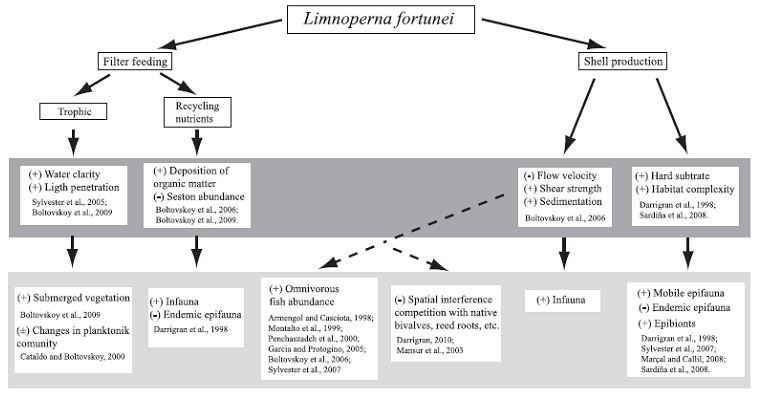
Ecosystem engineers are agencies that create, modify or maintain habitats (or micro-hábitats) causing a change in the physical state of biotic and abiotic materials that modulate, directly or indirectly, the availability of resources for other species (Jones et al. 1997). As a result, they often have effects on other members of the biota and their interactions and consequently global ecosystem processes. Ecosystem engineering is "the creation, modification and maintenance of Habitat (micro-hábitats) in charge of bodies" (Gutierrez et to the. 2003).The ecosystem engineering concept interconnects a number of important ecological and evolutionary concepts and is particularly relevant to environmental management (Gutiérrez and Jones, 2008). Based on such concepts, and on the fact that invaders that will have the largest impacts are those that directly modify ecosystems and thus have cascading effects for the resident biota (Crooks, 2002), this contribution reports L. fortunei as an important ecosystem engineer in freshwater systems. Although little is still known about its biology and interactions, it is estimated that – like D. polymorpha in the northern Hemisphere (Karatayev et al., 2007) – this species aggregates into beds, thus modifying the nature and complexity of the substrate in a way similar to its marine related taxa (Borthagaray and Carranza, 2007). Upon invading the Plata basin, the golden mussel had an impact on different communities, altering the composition of the benthic fauna (Darrigran et al., 1998; Sylvester et al., 2007; Sardiña et al., 2008), predator diets (Penchaszadeh et al., 2000; García and Protogino, 2005; Sylvester et al., 2007), and physical conditions of the soil and water column (Sylvester et al., 2005, 2006).
REFERENCE
1) Jones C., Lawton J., Shachak M. (1997) Positive and negative effects of organisms as physical ecosystem engineers. Ecology 78: 1946-1957
2) Gutiérrez J., Jones C., Strayer D., Iribarne O. (2003) Mollusks as ecosystem engineers: the role of shell production in aquatic habitats. Oikos 101: 79-90.
3) Gutiérrez JLC, Jones CG (2008) Encyclopedia of Life Sciences. John Wiley & Sons, Chichester
4) Crooks JA (2002) Characterizing ecosystem-level consequences of biological invasions: the role of ecosystem engineers. Oikos 97: 153–166
5) Karatayev AY, Boltovskoy D, Padilla DK, Burlakova LE (2007) The invasive bivalves Dreissena polymorpha and Limnoperna fortunei: parallels, contrasts, potential spread and invasion impacts. J Shellfish Res 26: 205–213
6) Borthagaray AI, Carranza A (2007) Mussels as ecosystem engineers: Their contribution to species richness in a rocky littoral community. Acta Oecol : 243–250
7) Darrigran G, Martin SM, Gullo B, Armendariz L (1998) Macroinvertebrados associated to the byssus of Limnoperna fortunei (Dunker, 1857) (Pelecipoda, Mytilidae) Río de la Plata, Argentina. Hydrobiologia 367: 223-230
8) Sylvester F, Boltovskoy D, Cataldo D (2007) Fast response of freshwater consumers to a new trophic resource: Predation on the recently introduced Asian bivalve Limnoperna fortunei in the lower Paraná river, South America. Austral Ecol 32: 403–415
9) Sardiña P, Cataldo DH, Boltovskoy D (2008) The effects of the invasive mussel, Limnoperna fortunei, on associated fauna in South American freshwaters: importance of physical structure and food supply. Fundam Appl Limnol Arch Hydrobiol 173: 135–144
10)Penchaszadeh PE, Darrigran G, Angulo C, Averbuj A, Brögger M, Dogliotti A, Pírez N (2000) Predation of the invasive freshwater mussel Limnoperna fortunei (Dunker, 1857) by the fish Leporinus obtusidens Valenciennes, 1846 (Anostomidae) in the Río de la Plata, Argentina. J Shellfish Res 19: 229-231
11) García M., Protogino L. (2005) Invasive freshwater molluscs are consumed by native fishes in South America. J App Ichthyol 21: 34-38
12) Sylvester F, Dorado J, Boltovskoy D, Juárez A, Cataldo D (2005) Filtration rates of the invasive pest bivalve Limnoperna fortunei as a function of size and temperature. Hydrobiologia 534: 71–80
13) Sylvester F, Boltovskoy D, Cataldo D (2006) Tasas de clareado: ritmos e impacto. In: Darrigran G, Damborenea C (Eds) Bio-invasion del mejillón dorado en el continente americano. Edulp, La Plata pp 129-139
For
more information contact
us by e-mail:
invasion@fcnym.unlp.edu.ar
gdarrigran@hotmail.com
gdarrigran@malacología.com.ar